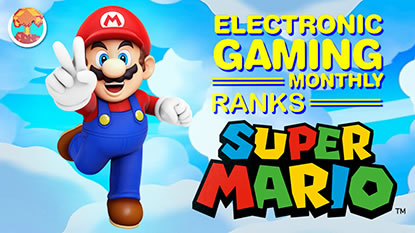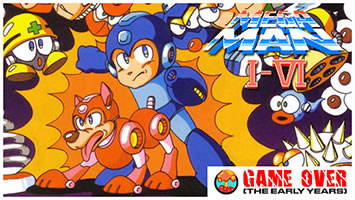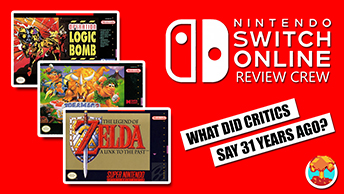- CLASSIC MAGAZINES
- REVIEW CREW
A show recapping what critics thought back
when classic games first came out! - NEXT GENERATION'S BEST & WORST
From the worst 1-star reviews to the best
5-stars can offer, this is Next Generation! - NINTENDO POWER (ARCHIVE)
Experience a variety of shows looking at the
often baffling history of Nintendo Power! - MAGAZINE RETROSPECTIVE
We're looking at the absolutely true history of
some of the most iconic game magazines ever! - SUPER PLAY'S TOP 600
The longest and most ambitious Super NES
countdown on the internet! - THEY SAID WHAT?
Debunking predictions and gossip found
in classic video game magazines! - NEXT GENERATION UNCOVERED
Cyril is back in this spin-off series, featuring the
cover critic review the art of Next Generation! - HARDCORE GAMER MAGAZING (PDF ISSUES)
Download all 36 issues of Hardcore Gamer
Magazine and relive the fun in PDF form!
- REVIEW CREW
- ELECTRONIC GAMING MONTHLY
- ELECTRONIC GAMING MONTHLY RANKS
From Mario to Sonic to Street Fighter, EGM
ranks classic game franchises and consoles! - ELECTRONIC GAMING MONTHLY BEST & WORST
Counting down EGM’s best and worst reviews
going year by year, from 1989 – 2009! - ELECTRONIC GAMING BEST & WORST AWARDS
11-part video series chronicling the ups and
downs of EGM’s Best & Worst Awards!
- ELECTRONIC GAMING MONTHLY RANKS
- GAME HISTORY
- GAME OVER: STORY BREAKDOWNS
Long-running series breaking down game
stories and analyzing their endings! - A BRIEF HISTORY OF GAMING w/ [NAME HERE]
Real history presented in a fun and pithy
format from a variety of game historians! - THE BLACK SHEEP
A series looking back at the black sheep
entries in popular game franchises! - INSTANT EXPERT
Everything you could possibly want to know
about a wide variety of gaming topics! - FREEZE FRAME
When something familiar happens in the games
industry, we're there to take a picture! - I'VE GOT YOUR NUMBER
Learn real video game history through a series
of number-themed episodes, starting at zero! - GREAT MOMENTS IN BAD ACTING
A joyous celebration of some of gaming's
absolute worst voice acting!
- GAME OVER: STORY BREAKDOWNS
- POPULAR SHOWS
- DG NEWS w/ LORNE RISELEY
Newsman Lorne Riseley hosts a regular
series looking at the hottest gaming news! - REVIEW REWIND
Cyril replays a game he reviewed 10+ years
ago to see if he got it right or wrong! - ON-RUNNING FEUDS
Defunct Games' longest-running show, with
editorials, observations and other fun oddities! - DEFUNCT GAMES QUIZ (ARCHIVE)
From online quizzes to game shows, we're
putting your video game knowledge to the test!- QUIZ: ONLINE PASS
Take a weekly quiz to see how well you know
the news and current gaming events! - QUIZ: KNOW THE GAME
One-on-one quiz show where contestants
find out if they actually know classic games! - QUIZ: THE LEADERBOARD
Can you guess the game based on the classic
review? Find out with The Leaderboard!
- QUIZ: ONLINE PASS
- DEFUNCT GAMES VS.
Cyril and the Defunct Games staff isn't afraid
to choose their favorite games and more! - CYRIL READS WORLDS OF POWER
Defunct Games recreates classic game
novelizations through the audio book format!
- DG NEWS w/ LORNE RISELEY
- COMEDY
- GAME EXPECTANCY
How long will your favorite hero live? We crunch
the numbers in this series about dying! - VIDEO GAME ADVICE
Famous game characters answer real personal
advice questions with a humorous slant! - FAKE GAMES: GUERILLA SCRAPBOOK
A long-running series about fake games and
the people who love them (covers included)! - WORST GAME EVER
A contest that attempts to create the worst
video game ever made, complete with covers! - LEVEL 1 STORIES
Literature based on the first stages of some
of your favorite classic video games! - THE COVER CRITIC
One of Defunct Games' earliest shows, Cover
Critic digs up some of the worst box art ever! - COMMERCIAL BREAK
Take a trip through some of the best and
worst video game advertisements of all time! - COMIC BOOK MODS
You've never seen comics like this before.
A curious mix of rewritten video game comics!
- GAME EXPECTANCY
- SERIES ARCHIVE
- NINTENDO SWITCH ONLINE ARCHIVE
A regularly-updated list of every Nintendo
Switch Online release, plus links to review! - PLAYSTATION PLUS CLASSIC ARCHIVE
A comprehensive list of every PlayStation
Plus classic release, including links! - RETRO-BIT PUBLISHING ARCHIVE
A regularly-updated list of every Retro-Bit
game released! - REVIEW MARATHONS w/ ADAM WALLACE
Join critic Adam Wallace as he takes us on a
classic review marathon with different themes!- DEFUNCT GAMES GOLF CLUB
Adam Wallace takes to the links to slice his way
through 72 classic golf game reviews! - 007 IN PIXELS
Adam Wallace takes on the world's greatest spy
as he reviews 15 weeks of James Bond games! - A SALUTE TO VAMPIRES
Adam Wallace is sinking his teeth into a series
covering Castlevania, BloodRayne and more! - CAPCOM'S CURSE
Adam Wallace is celebrating 13 days of Halloween
with a line-up of Capcom's scariest games! - THE FALL OF SUPERMAN
Adam Wallace is a man of steel for playing
some of the absolute worst Superman games! - THE 31 GAMES OF HALLOWEEN
Adam Wallace spends every day of October afraid
as he reviews some of the scariest games ever! - 12 WEEKS OF STAR TREK
Adam Wallace boldly goes where no critic has
gone before in this Star Trek marathon!
- DEFUNCT GAMES GOLF CLUB
- DAYS OF CHRISTMAS (ARCHIVE)
Annual holiday series with themed-episodes
that date all the way back to 2001!- 2015: 30 Ridiculous Retro Rumors
- 2014: 29 Magazines of Christmas
- 2013: 29 Questionable Power-Ups of Christmas
- 2012: 34 Theme Songs of Christmas
- 2011: 32 Game Endings of Christmas
- 2010: 31 Bonus Levels of Christmas
- 2009: 30 Genres of Christmas
- 2008: 29 Controls of Christmas
- 2007: 34 Cliches of Christmas
- 2006: 33 Consoles of Christmas
- 2005: 32 Articles of Christmas
- 2004: 31 Websites of Christmas
- 2003: 29 Issues of Christmas
- 2002: 28 Years of Christmas
- 2001: 33 Days of Christmas
- NINTENDO SWITCH ONLINE ARCHIVE
- REVIEW ARCHIVE
- FULL ARCHIVE
In Search of the Average Game Score
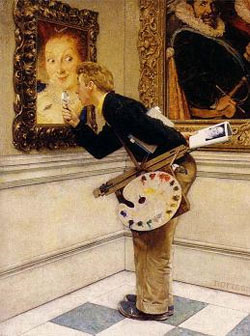
I give this commentary on art critics a 50%! Or maybe it's 70% ... whatever average is these days!
It's bad enough that these people rush past the paragraphs I spend so much time putting together, but half the time they don't even go to the review site. Instead of going to a website to see the score, they get the information from a forum or worse, from one of those Metacritic-style review aggregators. They just scan the numbers to see what they should and should not buy, keeping the critics almost entirely out of the process.

These days sites like GameSpot and IGN seem conflicted on what number denotes "average"!
For years a 5 has been used to denote that the game is average, since that's right in the middle of the grading scale. However, lately a lot of game critics have started to take a different approach, making 7 the so-called

We're not going to talk about Incite Video Gaming, but that's not going to stop me from posting this picture (again)!
But it hasn't always been like this. Issuing the 7 as an average score is a relatively new phenomenon when it comes to the video games industry. It didn't use to be this way, but thanks to a giant influx of internet game journalists and websites that often hide (or simply do not publish) their score guide, more journalists are just using this 7 average by default. This made me wonder, where did this new scoring table come from and who started it? This sounds like a perfect occasion for my sleuth hat and reading glasses.
When talking about game scores on a ten-point scale you can immediately eliminate certain magazines. While GamePro may be the longest running video game magazines still in business, their scores are based

If you accept IGN and GameSpot's scoring system, then Devil's Crush (reviewed in the above issue) is merely average!
When it comes to game magazines, a safe bet is to start with Electronic Gaming Monthly. Although the magazine was unceremoniously killed earlier this year (and later brought back to life by Steve Harris, the original creator of EGM), it did have a twenty year run and, with the
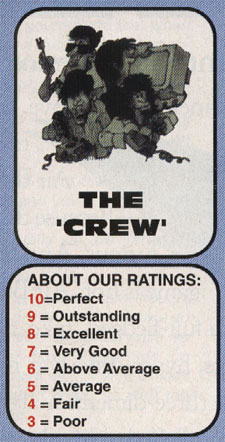
It's not pretty (or even centered correctly), but this is the rating's guide EGM used for years!
Electronic Gaming Monthly has always been good about telling their readers what each score meant. Even back in the first year, EGM made it a point to explain that 10 was a perfect, 9 was outstanding, 8 was excellent, 7 was very good, 6 was above average and five was the average. That useful bit of information could always be found on the first review page, something that the magazine ultimately stuck with throughout their two decade run.
Things didn't change any when I went from issue 15 in 1990 to issue 75 in 1995. The game critics and magazine layout may have changed, but the 5 average remained the same. The same held true for issue 135 in 2000 and 185 in 2005, this is a magazine that was consistent with their review scores. Even in the issues

Adjusted for inflation, this 30 page magazine retailed for close to $5!
After putting all of my old issues of EGM away, I decided to check out some of Sendai Publishing's other video game magazines. This involved me digging up my old issues of Mega Play (the Sega-centric magazine put out by the editors of EGM) and Super Gaming (their Nintendo offshoot). Both magazines featured a
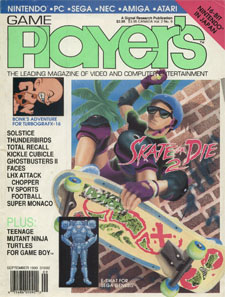
I agree with Bonk, I'd slam my head into something too if I had to review Skate Or Die!
After striking out with Electronic Gaming Monthly and its spin-offs, I decided to look through some of the older issues of Game Players. Nobody remembers this now, but back in the early to mid 1990s, Game Players was a strong competitor with GamePro and EGM. For many issues Game Players refused to issue scores (something we talked in great detail about in an article called In the Beginning There Were No Reviews), but in 1991 that all changed. For the first time in the magazine's short life, Game Players posted a review scale and started being honest about what they really thought of the biggest games of the era. And what was the average score? You guessed it, Game Players said that 5 was the average. And four years later they continued to say the exact same thing, only this time around referring to average as, and I quote, "so-so".
Up until this point things have gone pretty much as I expected. I remember spending a lot of time reading these old magazines and knowing that 5 was the average, so nothing so far as surprised me. But still, I decide to press on, in hopes of finding the birthplace of the 7 average.






HOME |
CONTACT |
NOW HIRING |
WHAT IS DEFUNCT GAMES? |
NINTENDO SWITCH ONLINE |
RETRO-BIT PUBLISHING
Retro-Bit |
Switch Planet |
The Halcyon Show |
Same Name, Different Game |
Dragnix |
Press the Buttons
Game Zone Online | Hardcore Gamer | The Dreamcast Junkyard | Video Game Blogger
Dr Strife | Games For Lunch | Mondo Cool Cast | Boxed Pixels | Sega CD Universe | Gaming Trend
Game Zone Online | Hardcore Gamer | The Dreamcast Junkyard | Video Game Blogger
Dr Strife | Games For Lunch | Mondo Cool Cast | Boxed Pixels | Sega CD Universe | Gaming Trend
Copyright © 2001-2025 Defunct Games
All rights reserved. All trademarks are properties of their respective owners.
All rights reserved. All trademarks are properties of their respective owners.













